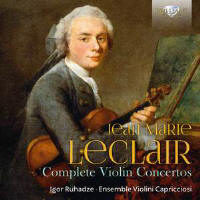Texte paru dans: / Appeared in:
Brilliant Classicsi |
|
|
Outil de traduction ~ (Très approximatif) |
|
|
Reviewer: Jerry
Dubins Jean-Marie Leclair (1697–1764) is considered the father of the French violin school, though he studied in Italy and brought back to France with him Corelli’s fine-spun legato cantilena and Locatelli’s flair for the virtuosic. Leclair’s murder remains an unsolved mystery, though it’s tempting to speculate on the motive. After listening to three and half hours of these concertos, I fear I might have killed him myself just to put a stop to any more of his damn fiddling.
A number of players, mostly of
the HIP persuasion, have dipped their bows into Leclair’s concertos, among
them Simon Standage, Jaap Schröder, and Monica Huggett. But even non-HIPsters
such as Yehudi Menuhin and Pinchas Zukerman included Leclair on discs of
concertos by other Baroque violinist-composers.
All told, Leclair composed
around 100 works, but the majority of them are sonatas for one or two
violins. Only 12 of his known compositions are concertos for violin,
strings, and continuo—six of them published as op. 7, and six published as
op. 10. Igor Ruhadze and the Ensemble Violini Capricciosi give us all 12 of
them in this three-disc (in physical form) Brilliant Classics set. Back in
the late 1980s and early 1990s, violinist Daniel Cuiller and the Ensemble
Stradivaria did likewise, but I’ve not seen or heard those recordings. They
were well received, however, in reviews by Nils Anderson and Robert Maxham.
Leclair’s resourcefulness for
virtuosic fingering and bowing tricks at first seems inexhaustible, but
attentive listening soon reveals that the tricks are few and largely
recycled from one concerto to the next, with string-crossing arpeggios,
double-stop and bariolage effects, and various bowing articulations being
his main acts. Moreover, Leclair, whose dates are virtually identical to
Locatelli’s (1695–1764), is not as daring or adventurous as his Italian
counterpart in exploring and exploiting the violin’s upper regions and other
technique-stretching exercises.
But my main complaint about
Leclair, at least insofar as his concertos are concerned, is that he seems
to lack the melody gene. Even in the slow movements, which should afford the
opportunity for long-breathed, sustained song, Leclair doesn’t know how to
sing. His strongly developed rhythmic sense in the outer movements, however,
is no doubt attributable to his early musical training in dance, and to his
membership from the age of 19 in the dancers’ corps at the Lyons opera. The too-much-of-a-sameness of these 12 concertos is, frankly, tiresome, and I wouldn’t advise sitting down to listen to them all at once. The playing, however, by Igor Kuhadze and the Ensemble Violini Capricciosi, which he founded, is really top-notch. In addition to Kuhadze, there are two more violins, one viola, one cello, one double bass, and a harpsichord. The string instruments are all of original 18th- and 19th-century vintage. The harpsichord is a modern copy of a 1750 Dulcken. The group’s robust sound belies its small numbers, and its execution avoids the scooping, swooping, and pallid tone that often attends one-to-a-part period instrument performances, which is what these are. Philosophically, I’m not in favor of one-to-a-part performances such as these, which, essentially, redefine the concept of “concerto” to mean a work for soloist accompanied by a string quartet instead of an orchestra, but it’s hard to argue with playing as good as this. | |
|
|
|
|
Cliquez l'un ou l'autre
bouton pour découvrir bien d'autres critiques de CD |
|




